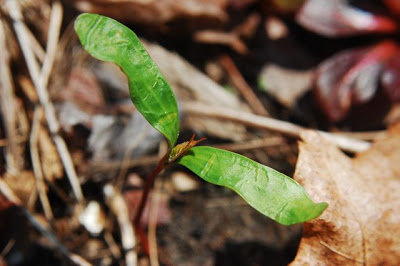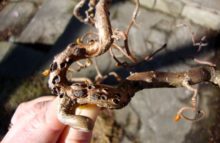This little seedling of the Norway maple (Acer platanoides) is one of the small forest that germinates in my garden each spring. The maples are a constant reminder of the old chestnut (as in: saying) in the title.
Why would you get seven years of weeds from one year of seeds? One reason is that it’s a form of plant birth control.
Perennial plants live and reproduce for many years.
Therefore, to varying degrees, their seeds are genetically programmed not to germinate all at once. By having some seeds lie dormant for a few years, the species spreads the fruits of one year’s fertility over many. This ensures its survival should future seasons be less hospitable for reproduction.
Think about it; if every year, every single seed produced a fertile plant that lived for many years (each year, producing many seeds, every on
e of which produced a fertile plant, and so on), th
e species would overpopulate.
This prudence doesn’
t only apply to weeds – remembering that “a weed” can simply be any plant growing in the wrong place.
If you like a flower, for example, but it self-seeds too abundantly, a solution is simple: don’t let it go to seed.
Deadhead the plant after blooming, before the seeds ripen. Some of the colonizing spring bulbs (such as the Scilla or Chionodoxa we posted about earlier) might fall into this category if you find them becoming a pest in your garden.
Or, if you’re disappointed when trying to start flowers from seed, be patient. Some seeds just take longer.
Others have to be helped along by techniques such as pre-soaking or by nicking the seed coat. The seed packet will recommend your best strategy for this. Don’t skip that step.
By the same token, if you’ve been weeding: don’t add ripe weed seeds to your compost pile, unless your pile gets hot enough to kill them.
Back to the Norway maple. It produces a truckload of viable seeds, meaning seeds that will sprout. (As an aside, the lovely native sugar maple, A. saccharum, is very stingy with its own – which has helped the Norways run rampant through our naturalized ravines.)
I can
‘t do anything about deadheading trees, and don’t have room to create a nice hot compost pile. Plus, my yearly mulch of uncomposted maple leaves will always contain seeds.
So I’ve developed another kind of patience, and learned to accept the seedlings. Pulling them up has become a perennial rite of spring. As I do, I fortify myself with this mantra: One year’s seeds…



